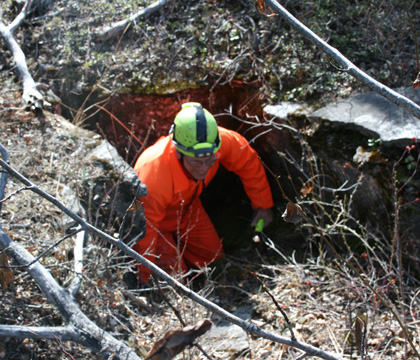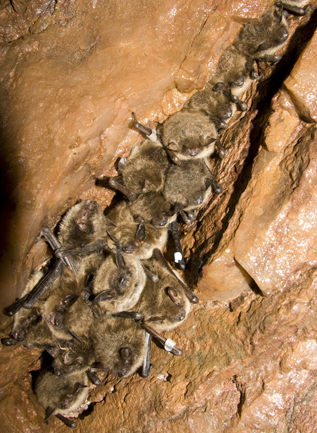
Bat-killing fungus is European invader
Results from an experiment conducted in a University of Saskatchewan bio-safety lab suggest that bats in North America are dying from a European strain of fungus recently introduced to Canada and the United States.
By Myrna MacDonald
White-nose syndrome (WNS) is an emerging disease of hibernating bats that's associated with a skin infection caused by the fungus Geomyces destructans (Gd). The fungus grows in the skin of the bat, producing a white residue on the muzzle, wings and ears.
"Our results showing that the European strain of the fungus, which doesn't adversely affect bats in Europe, is just as virulent as the American variety suggests a recent introduction to our continent," says Dr. Vikram Misra, a microbiologist at the Western College of Veterinary Medicine (WCVM) and member of the research team.
"These results give us hope that North America's bat populations may recover as they have done in Europe."
The research team also learned how and why the fungus kills bats. In the study, both European and North American strains of the fungus cause bats to wake up more often during hibernation — a process that depletes the creatures' fat stores and leads to starvation and death.

The research, which was published on April 9 in Proceedings of the National Academy of Sciences, was led by University of Winnipeg biologist Dr. Craig Willis and performed by scientists from Manitoba, Saskatchewan, United States and Germany.
The team included two U of S researchers: Misra is head of the WCVM's Department of Veterinary Microbiology and WCVM pathologist Dr. Trent Bollinger who is also regional director of the Canadian Cooperative Wildlife Health Centre's western/northern region.
"Bats make very important — and often underestimated — contributions to the health of our ecosystem. White-nose syndrome has the potential of decimating their numbers and driving some species of bats to extinction. Information about the course of the disease and why it kills bats may help to limit the devastation caused by WNS," explains Misra, who also co-authored the first published report on viruses in Canadian bats with Willis and Manitoba biologist Dr. Jack Dubois, another member of the WNS research team.
First detected in the eastern U.S. in 2007, WNS continues to spread across the continent and is responsible for the death of millions of bats in Eastern Canada and the U.S. In contrast, the Gd fungus has been found on bats throughout Europe but doesn't cause the mass mortality that researchers have witnessed among North American bat populations.

To better understand what exactly is killing the bats, researchers collected disease-free bats from caves in Manitoba and brought them to the WCVM's Animal Care Unit — a U of S facility that offered ideal conditions for conducting the WNS experiment.
"The disease was already in eastern U.S. and Canada, making it impossible to collect bats that were free of the Gd fungus," explains Misra. "We had the appropriate facilities, the pathology and microbiology expertise and a source of large numbers of disease-free bats in neighbouring Manitoba."
Using strict biosecurity precautions, the scientists inoculated two groups with North American and European strains of Gd while a third control group received no treatment. For the next four months, University of Winnipeg postdoctoral fellows Drs. Lisa Warnecke and James Turner used video cameras and body temperature sensors to monitor the hibernating bats that were kept in climate-controlled, Level 2 containment rooms at the WCVM.

After final analysis, results showed both strains of the fungus were deadly — the European strain even more so — to bats. Besides learning more about how the fungal infection increases the frequency with which the bats wake up from hibernation, Misra says researchers were also able to satisfy Koch's Postulates (criteria designed to establish a causal relationship between a microbe and a disease). The study's results confirmed that the Gd fungus is the cause of WNS and the mortality associated with the disease.
In April, Warnecke and Turner completed another experiment that examines the effects of humidity on the severity of WNS as well as how the disease progresses in bats. WNS team members will analyze data and samples from this study over the next few months.
The team also plans to look at how bats cope with the stress of the disease by turning on stress-response genes, and preliminary research in this area has already been done by one of the WCVM's third-year veterinary students.
"Our results showing that the European strain of the fungus, which doesn't adversely affect bats in Europe, is just as virulent as the American variety suggests a recent introduction to our continent," says Dr. Vikram Misra, a microbiologist at the Western College of Veterinary Medicine (WCVM) and member of the research team.
"These results give us hope that North America's bat populations may recover as they have done in Europe."
The research team also learned how and why the fungus kills bats. In the study, both European and North American strains of the fungus cause bats to wake up more often during hibernation — a process that depletes the creatures' fat stores and leads to starvation and death.

The research, which was published on April 9 in Proceedings of the National Academy of Sciences, was led by University of Winnipeg biologist Dr. Craig Willis and performed by scientists from Manitoba, Saskatchewan, United States and Germany.
The team included two U of S researchers: Misra is head of the WCVM's Department of Veterinary Microbiology and WCVM pathologist Dr. Trent Bollinger who is also regional director of the Canadian Cooperative Wildlife Health Centre's western/northern region.
"Bats make very important — and often underestimated — contributions to the health of our ecosystem. White-nose syndrome has the potential of decimating their numbers and driving some species of bats to extinction. Information about the course of the disease and why it kills bats may help to limit the devastation caused by WNS," explains Misra, who also co-authored the first published report on viruses in Canadian bats with Willis and Manitoba biologist Dr. Jack Dubois, another member of the WNS research team.
First detected in the eastern U.S. in 2007, WNS continues to spread across the continent and is responsible for the death of millions of bats in Eastern Canada and the U.S. In contrast, the Gd fungus has been found on bats throughout Europe but doesn't cause the mass mortality that researchers have witnessed among North American bat populations.

To better understand what exactly is killing the bats, researchers collected disease-free bats from caves in Manitoba and brought them to the WCVM's Animal Care Unit — a U of S facility that offered ideal conditions for conducting the WNS experiment.
"The disease was already in eastern U.S. and Canada, making it impossible to collect bats that were free of the Gd fungus," explains Misra. "We had the appropriate facilities, the pathology and microbiology expertise and a source of large numbers of disease-free bats in neighbouring Manitoba."
Using strict biosecurity precautions, the scientists inoculated two groups with North American and European strains of Gd while a third control group received no treatment. For the next four months, University of Winnipeg postdoctoral fellows Drs. Lisa Warnecke and James Turner used video cameras and body temperature sensors to monitor the hibernating bats that were kept in climate-controlled, Level 2 containment rooms at the WCVM.

After final analysis, results showed both strains of the fungus were deadly — the European strain even more so — to bats. Besides learning more about how the fungal infection increases the frequency with which the bats wake up from hibernation, Misra says researchers were also able to satisfy Koch's Postulates (criteria designed to establish a causal relationship between a microbe and a disease). The study's results confirmed that the Gd fungus is the cause of WNS and the mortality associated with the disease.
In April, Warnecke and Turner completed another experiment that examines the effects of humidity on the severity of WNS as well as how the disease progresses in bats. WNS team members will analyze data and samples from this study over the next few months.
The team also plans to look at how bats cope with the stress of the disease by turning on stress-response genes, and preliminary research in this area has already been done by one of the WCVM's third-year veterinary students.
